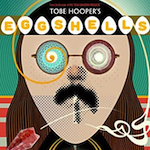 Holy shit you guys, I never really thought I’d see EGGSHELLS! It’s the weird psychedelic movie Tobe Hooper made in 1969 – five years before THE TEXAS CHAIN SAW MASSACRE. According to Hooper it only really played about fifty times, and only in Texas. It had never been on video until 2013, when it was included as a bonus disc for Arrow’s Region B limited edition of THE TEXAS CHAINSAW MASSACRE 2. I didn’t know about it in time to get it.
Holy shit you guys, I never really thought I’d see EGGSHELLS! It’s the weird psychedelic movie Tobe Hooper made in 1969 – five years before THE TEXAS CHAIN SAW MASSACRE. According to Hooper it only really played about fifty times, and only in Texas. It had never been on video until 2013, when it was included as a bonus disc for Arrow’s Region B limited edition of THE TEXAS CHAINSAW MASSACRE 2. I didn’t know about it in time to get it.
But recently a copy of that disc was donated to the collection of Scarecrow Video, so I checked it out. It’s a beautiful restoration and the disc includes a Hooper commentary track, which I’m glad I listened to, because it sure gave me a better idea what was supposed to be going on. You wouldn’t necessarily know this was the work of a future Master of Horror, because it hadn’t yet occurred to him that the horror genre was a good hook to get your movie played in drive-ins. There’s possibly a supernatural force in it, but it’s not used for scares – just trippiness, I’d say.
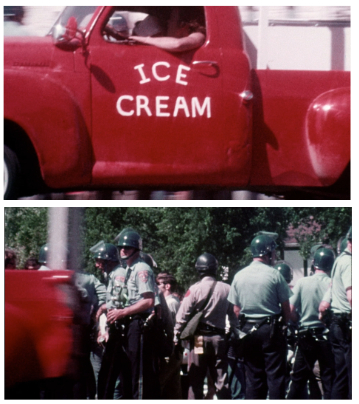 It opens following a young woman (Mahlon Foreman, THE WINDSPLITTER) into Austin to attend University of Texas. The late sixties-ness is immediate: a lens-flared shot of the flag moves down to show a crowd of students protesting the war. There’s a shot that I’m sure wasn’t planned, but it’s almost too good to be true: a red pick up truck that says “ICE CREAM” on the side drives by, and once it’s passed we see the line of riot cops behind it.
It opens following a young woman (Mahlon Foreman, THE WINDSPLITTER) into Austin to attend University of Texas. The late sixties-ness is immediate: a lens-flared shot of the flag moves down to show a crowd of students protesting the war. There’s a shot that I’m sure wasn’t planned, but it’s almost too good to be true: a red pick up truck that says “ICE CREAM” on the side drives by, and once it’s passed we see the line of riot cops behind it.
This was clearly a real event, but Hooper was able to get good shots of the police line, and cuts between closeups of their clubs, their guns, their helmets. Later a character will claim that eleven protesters were bayonetted, but Hooper doesn’t play up any conflict – in fact, he zooms in on protesters taking turns shaking one cop’s hand. It’s actually a pretty mellow protest, from what we see.
There are many shots of a clock tower, which made me think, “Wait a minute, isn’t that—?” Yes, that is the clock tower that an infamous mass murderer shot people from in 1966. What I didn’t know was that Hooper was there when it happened. So it’s hard to imagine him not seeing that thing as ominous, but maybe he didn’t know it would have that meaning to us.
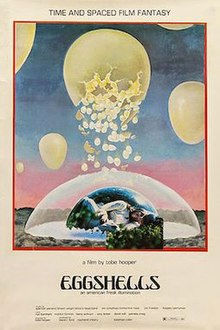 For Mahlon college and Austin seems to be a whole new world compared to whatever small town she came from. She walks around, her eyes bugged out, looking into shop windows, being handed a counterculture newspaper called The Rag. Her trip and the protest are basically an 8-minute musical montage, set to some song I’m assuming is by the Austin band Shiva’s Headband, since they’re credited with the music. I don’t know how connected Hooper was to the music of the time, but according to the commentary he’d already filmed his Peter Paul and Mary documentary THE SONG IS LOVE (though it was released in 1971 according to IMDb).
For Mahlon college and Austin seems to be a whole new world compared to whatever small town she came from. She walks around, her eyes bugged out, looking into shop windows, being handed a counterculture newspaper called The Rag. Her trip and the protest are basically an 8-minute musical montage, set to some song I’m assuming is by the Austin band Shiva’s Headband, since they’re credited with the music. I don’t know how connected Hooper was to the music of the time, but according to the commentary he’d already filmed his Peter Paul and Mary documentary THE SONG IS LOVE (though it was released in 1971 according to IMDb).
Then we move to the film’s primary location, a big house in a wooded area that a bunch of hippies live in. Hooper says it was a house some of his friends were renting. We first see a guy sitting on the porch when a paper airplane with elaborate designs drawn all over it swoops in, hits the house, and explodes. It falls down in flames and the guy pours some of his milk on it.
Later we see a guy frantically working at a typewriter in a space under the porch. He has a big handlebar mustache and oh shit, that’s Kim Henkel, co-writer of THE TEXAS CHAIN SAW MASSACRE as well as this film. He also wrote and directed TEXAS CHAINSAW MASSACRE: THE NEXT GENERATION and wrote BUTCHER BOYS, but I recognized him because he also acted in a great non-horror movie he wrote called LAST NIGHT AT THE ALAMO (1983). (Somebody really needs to put that one on blu-ray.)
Henkel’s character is named Toze, and he’s a writer who types up funny little stories and has his friends read them out loud. One of them is about a guy named Ben Skabarsek who lives in the basement and doesn’t want people to know when he comes up to use the bathroom so he covers the sound by playing harmonica. Later other characters talk about there being a ghost in the house. I kinda wondered what was up with this, and on the commentary Hooper confirms that the guy on the porch is both Ben Skabarsek and the ghost. He describes him as an “ethereal character” and says “he’s kinda in another dimension actually” and “he’s a kind of a spirit of the psychedelic energy.”
Said psychedelic energy is depicted through a moving POV shot kind of like an EVIL DEAD one, but I believe done with what used to be called pixelation (basically time lapse while moving the camera). The energy travels around Austin and decides to nest in the basement of the house before they moved in. Hooper calls it “the hyper-electric crypto-embryonic presence.” I guess if one of the A24 guys said that I could understand why it would be considered pretentious, but when Hooper casually croaks it out in his drawl you have no choice but to love the man. Okay, so that’s what that was. A hyper-electric crypto-embryonic presence. I get it now.
I did notice that the Ben Skabarsek guy’s scenes are mostly separate, but there are a few where he’s walking around with the others, so I thought I was imagining it. I guess they never interact with him. A SIXTH SENSE type deal. In the basement he finds a glowing plexiglass dome against a wall. He gets a sword and maybe tries to fight it or something. There are various weird effects, etc. Hooper describes one part with distorted reflections of sexual activity as “when I first discovered mylar.”
Probly the best scene in the movie is when Toze is driving his big old painted hippie car with the plastic dome on top (“I don’t know why anybody would even need a plastic bubble” Hooper admits when discussing where he bought it from). He pulls over, starts a fire inside the car, then (seemingly as an afterthought) strips naked, throwing his clothes into the fire. Then he runs away as the car explodes. I’m not sure but I think there’s a shot where Henkel is for real naked in the same shot as an explosion. I don’t know what the meaning of any of that is, but it seems like he did what he had to do.
(Hooper calls it “activity happening in his head,” and later the car seems to be intact. Total cop out!)
My other favorite stuff is more down to earth. There are a couple long scenes with this couple Amy (Amy Lester) and Ron (Ron Barnhart) laying in a bath tub talking about their wedding that’s coming up, and about the protest, and what her dad would say about that, because he thinks everything is communist. And there’s another long scene where she’s standing on a stool wearing her wedding dress while her friend plans where to hem it and they all stand around talking to her. (Toze doesn’t believe in the institution of marriage.) What I like about these scenes is that it seems to be real people talking about real stuff (Hooper confirms that the wedding, which is seen in the movie, was real). It kind of reminds me of that documentary I like from around this time called DERBY. It’s not scripted, it’s not cinematic, but it’s a time capsule of these eccentric young people in a time before I was born. I mean I’d rather have a horror masterpiece, but a 16mm time capsule has some worth too.
Hooper is his own cinematographer on this one, and although he’s no Daniel Pearl there are some definite similarities to CHAIN SAW. This shot with an anthill in the foreground and the hippie car driving up in the background reminded me of TEXAS CHAIN SAW’s dead armadillo combined with that beautiful shot of the van driving along the horizon and stopping for the hitchhiker.
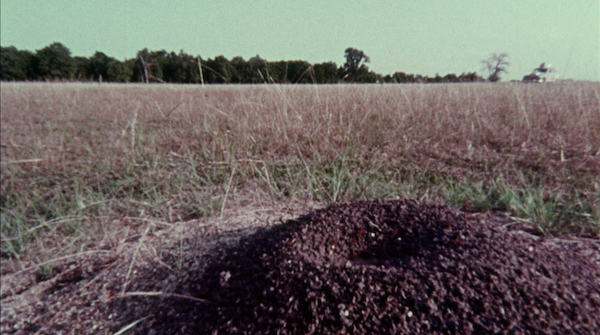 I’m not saying this is a better shot, but it’s worth noting that it contains both live ants and Kim Henkel running naked from a burning hippie car. Hooper was a real director is what I’m getting at.
I’m not saying this is a better shot, but it’s worth noting that it contains both live ants and Kim Henkel running naked from a burning hippie car. Hooper was a real director is what I’m getting at.
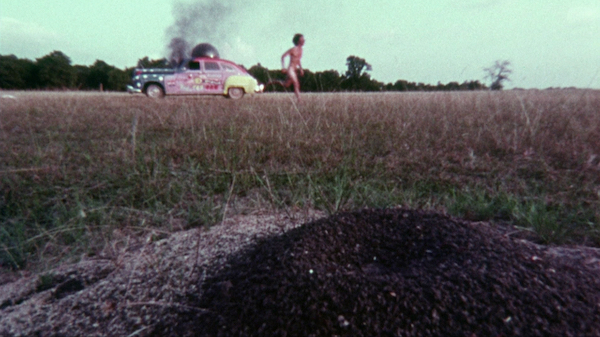
If I were to say “the most famous shot in THE TEXAS CHAIN SAW MASSACRE” I’m not sure what you would think – probly that one coming up behind Sally as she walks toward the house. But maybe #2 is that legendary scare with the camera looking in from the front door as Leatherface comes out, hits Kirk with the sledge, drags him into the room and slams the metal door shut. The one with this set up:

So check this out. Not the same house, but a similar shot, right?
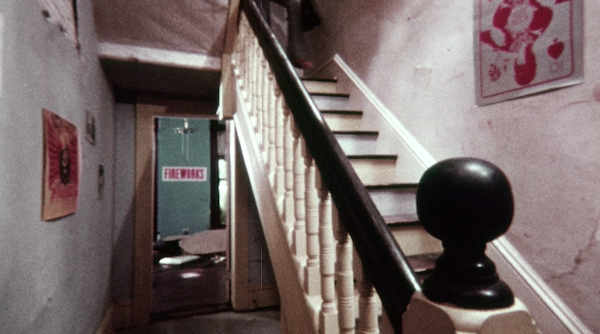
And it’s not just some random part. There’s a whole long sequence where they have a party and the entire thing stays locked at this angle, using jumpcuts to skip through time.
You see it a couple other times too. Weird. Hooper really liked stairway/door shots I guess. We should all make jokes about it the way people joke about John Woo’s doves and stuff.
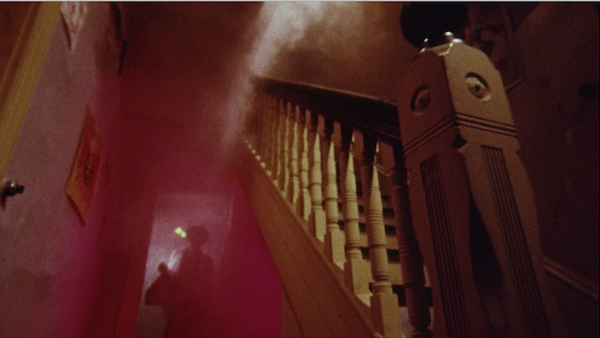
Allen Danziger, who you will recognize as Jerry from CHAIN SAW, plays their one friend who’s married and has a kid – his character is named Allen and his real wife Sharon plays his wife, so I assume it’s also their real kid. I thought that was funny because in CHAIN SAW he seems older and more square than the other characters, and I guess he probly was.

There’s a bunch of stuff involving multi-colored helium balloons. I don’t know what the symbolism is supposed to be, but they look nice in front of washed out backgrounds. At the end of the movie the characters (including the ghost) carry a weird device made out of a hair dryer through a construction site, then through a park. They set it up and sit under it, and it sucks them up, exhaling them as a cloud of smoke. “They get purified,” Hooper explains. “This is their pure spirit.”
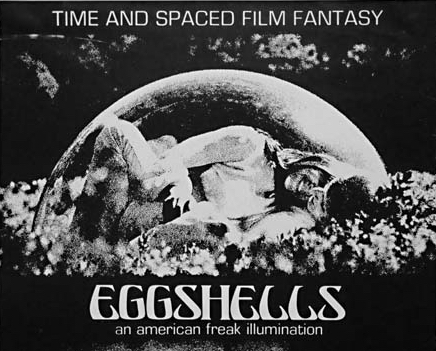 So obviously EGGSHELLS is not a movie I’d recommend to most people, but as someone fascinated with the Hooper catalog, and especially THE TEXAS CHAIN SAW MASSACRE – I’m talking about myself here – it’s honestly a revelation. For all these years we’ve heard interpretations of CHAIN SAW as a manifestation of the violence and bad mojo of the Vietnam years, with nothing literal in the text that points to that, so it’s always seemed to me like a sensible but not definitive analysis. But the long anti-war demonstration sequence here proves that the subject was very much on Hooper’s mind a few years earlier.
So obviously EGGSHELLS is not a movie I’d recommend to most people, but as someone fascinated with the Hooper catalog, and especially THE TEXAS CHAIN SAW MASSACRE – I’m talking about myself here – it’s honestly a revelation. For all these years we’ve heard interpretations of CHAIN SAW as a manifestation of the violence and bad mojo of the Vietnam years, with nothing literal in the text that points to that, so it’s always seemed to me like a sensible but not definitive analysis. But the long anti-war demonstration sequence here proves that the subject was very much on Hooper’s mind a few years earlier.
It’s also interesting to find that CHAIN SAW unconsciously (I assume) inverts the themes of EGGSHELLS. In CHAIN SAW we had the cool Austin hippie kids (plus Jerry) coming out to the rural area, seeing “bizarre crimes” they never could’ve imagined, only one young woman escaping in the back of a Chevy pickup truck. EGGSHELLS begins with the young woman, who Hooper says is being driven by her parents from her rural home town to her first day of college, and her eyes are opened to an exciting new world.
There are some knock out directorial debuts in horror – NIGHT OF THE LIVING DEAD, THE EVIL DEAD, HELLRAISER – and it’s easy to forget that CHAIN SAW isn’t one of them, because EGGSHELLS has always been so mysterious and inaccessible. But now that I’ve seen it it seems to me Hooper really had to do it first, as a training ground, and as a lab, to experiment with a bunch of shit, see if any of it works, or at least get it out of his system. Like, it was cool that he did the really long time lapse footage of a camera attached to the hood of the hippie car driving all through Austin, to the capitol, and then turning negative, set to a fast acoustic guitar jam, in this movie, and then not in CHAIN SAW. There are some psychedelic/experimental touches in CHAIN SAW – the solar flares on the opening credits, the strange clattering noises and echoes – that seem like an extension of the type of stuff he was messing around with in EGGSHELLS, but by employing them strategically within a genre structure they became more effective.
CHAIN SAW has some country music playing on radios that would be at home here, and the score gets pretty experimental, lots of hippie jamming on mouth harps and didgeridoos and shit. But it also has a few parts the subtitles qualify as “musical cacophony,” and that remind me of the sort of stuff Hooper and Wayne Bell used to score CHAIN SAW. (Incidentally, I noticed that Bell is credited as a p.a. here, as is CHAIN SAW assistant director Sallye Richardson. The assistant director on this one is TEXAS CHAINSAW MASSACRE 2 star Lou Perryman.)
Likely as important as anything Hooper learned here stylistically is the practice he got working with these actors. It’s a real cinema verite approach where it’s hard to imagine anything was scripted. CHAIN SAW applies that same natural feel to the characters and dialogue and I think that’s a huge part of its reputation of seeming like a documentary. The layman wouldn’t call them “good actors,” but also they don’t seem like they’re reading lines.
And by the way, the disc also includes Hooper’s 10-minute short from 1964, The Heisters, which is apparently meant as a parody of the Hammer movies he grew up on. You may be surprised to learn that Hooper started out as slapsticky as Sam Raimi did. I really don’t understand most of the humor, but I laughed when a guy got slapped with a glove and it was the glove from a suit of armor so his teeth fell out.
The Heisters has really good production values, it does not look something made by a film student. I can’t say I know where it connects to the rest of Hooper’s filmography other than to show that he was interested in getting laughs from the very beginning, even if it took a while for people to pick up on it in CHAIN SAW.
But I have no clue why it’s called EGSHELLS.
The post Eggshells first appeared on VERN'S REVIEWS on the FILMS of CINEMA.

